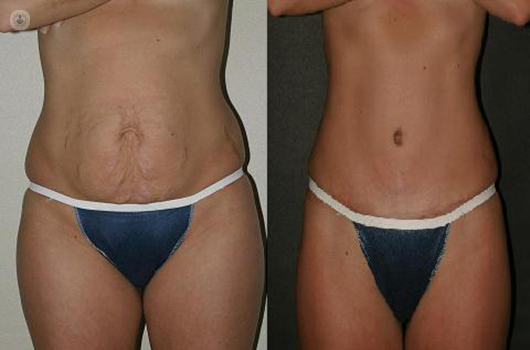What is a tummy tuck (abdominoplasty)?
An abdominoplasty, also known as a tummy tuck, is a cosmetic surgical procedure that flattens the abdomen by surgically removing excess skin and fat from the middle and lower abdomen. This allows the abdominal wall muscles to be tightened. This is a major procedure that requires general anaesthesia. It is not an alternative to weight loss.
Why have an abdominoplasty?
An abdominoplasty is suitable for men and women of a stable weight and in good health.
Women might consider having an abdominoplasty to remove excess skin resulting from pregnancy. Additionally, men and women who have lost a lot of weight are often left with lots of saggy, excess skin which can be removed from the abdomen with a tummy tuck.
How is an abdominoplasty carried out?
To begin with, a large incision is made across the lower abdomen. Through this incision, the skin from the abdominal wall underneath the belly button is separated and the excess skin of the abdomen is cut away and the excess fat removed. The incision is then closed with stitches.
An abdominoplasty can be either partial (mini tummy tuck) or complete, depending on how much excess skin and fat there is, and where it is mostly located. During a complete tummy tuck, it is likely that the belly button will need to be moved. Drainage tubes are placed in the incision to drain excess fluids following surgery.
Preparation for an abdominoplasty
It is important to stop smoking for a period before surgery, usually at least two weeks. Days before the operation it may be necessary to stop taking certain medications. There will also be a period of fasting before surgery.
Aftercare
The patient must keep in mind that the scar resulting from the operation is permanent, although its size will depend on the type of incision made according to the surgical requirements of each case.
The days following the procedure, the patient will have a little pain and discomfort, so the doctor will prescribe painkillers. You will need up to six weeks off work and exercise whilst you heal. You won’t be able to drive either for a number of weeks.
It may be necessary to wear a special elastic control support for a few weeks to encourage healing and to reduce swelling. After six weeks, you can stop wearing the elastic support and return to most normal activities.
11-13-2012 10-04-2023Tummy tuck (abdominoplasty)
Mr Venkat Ramakrishnan - Plastic surgery
Created on: 11-13-2012
Updated on: 10-04-2023
Edited by: Carlota Pano
What is a tummy tuck (abdominoplasty)?
An abdominoplasty, also known as a tummy tuck, is a cosmetic surgical procedure that flattens the abdomen by surgically removing excess skin and fat from the middle and lower abdomen. This allows the abdominal wall muscles to be tightened. This is a major procedure that requires general anaesthesia. It is not an alternative to weight loss.
Why have an abdominoplasty?
An abdominoplasty is suitable for men and women of a stable weight and in good health.
Women might consider having an abdominoplasty to remove excess skin resulting from pregnancy. Additionally, men and women who have lost a lot of weight are often left with lots of saggy, excess skin which can be removed from the abdomen with a tummy tuck.
How is an abdominoplasty carried out?
To begin with, a large incision is made across the lower abdomen. Through this incision, the skin from the abdominal wall underneath the belly button is separated and the excess skin of the abdomen is cut away and the excess fat removed. The incision is then closed with stitches.
An abdominoplasty can be either partial (mini tummy tuck) or complete, depending on how much excess skin and fat there is, and where it is mostly located. During a complete tummy tuck, it is likely that the belly button will need to be moved. Drainage tubes are placed in the incision to drain excess fluids following surgery.
Preparation for an abdominoplasty
It is important to stop smoking for a period before surgery, usually at least two weeks. Days before the operation it may be necessary to stop taking certain medications. There will also be a period of fasting before surgery.
Aftercare
The patient must keep in mind that the scar resulting from the operation is permanent, although its size will depend on the type of incision made according to the surgical requirements of each case.
The days following the procedure, the patient will have a little pain and discomfort, so the doctor will prescribe painkillers. You will need up to six weeks off work and exercise whilst you heal. You won’t be able to drive either for a number of weeks.
It may be necessary to wear a special elastic control support for a few weeks to encourage healing and to reduce swelling. After six weeks, you can stop wearing the elastic support and return to most normal activities.


All about tummy tuck and non-surgical alternatives
By Mr Aftab Siddiqui
2024-12-30
Here, distinguished consultant plastic and cosmetic surgeon, Mr Aftab Siddiqui, describes what a tummy tuck is, outlines the main non-surgical alternatives to a tummy tuck, and reveals the main reasons why someone might decide to undergo a tummy tuck. See more


An expert’s guide to abdominoplasty
By Mr Mark Ho-Asjoe
2024-12-30
Pregnancy, rapid or extreme weight loss, and natural ageing can all conspire to cause loose, sagging skin around the belly. However, with the growing popularity of plastic surgery comes a solution: abdominoplasty, also known as a “tummy tuck”. Esteemed plastic surgeon Mr Mark Ho-Asjoe explains: See more


Tummy tuck: why have it and possible complications of surgery
By Professor Charles Malata
2024-12-30
There are many reasons for a tummy tuck whether it's for a 'mummy makeover', to improve abdominal scars such as a caesarean section or whether you would like to dramatically improve the appearance of a protruding or saggy abdomen. Professor Charles Malata is a highly-experienced plastic surgeon and here he explains everything you need to know about abdominoplasty. See more


The Brazilian tummy tuck explained
By Mr Ian Grant
2024-12-30
Have you lost pounds, reached your goal weight but still not achieved your desired body shape? A Brazilian tummy tuck may just be for you! Expert plastic surgeon Mr Ian Grant explains how the procedure works and how it differs from a traditional abdominoplasty. See more
Experts in Tummy tuck (abdominoplasty)
-
Mr Mo Akhavani
Plastic surgeryExpert in:
- Breast augmentation
- Facelift
- Gynaecomastia
- Tummy tuck (abdominoplasty)
- Liposuction
-
Mr Maisam Fazel
SurgeryExpert in:
- Breast reconstruction
- Breast augmentation
- Tummy tuck (abdominoplasty)
- Oncoplastic and reconstructive breast surgery
- Gynaecomastia
- Breast reduction
-
Mr Nicholas Parkhouse
Plastic surgeryExpert in:
- Scars
- Moles
- Skin cancer
- Facelift
- Breast reduction
- Tummy tuck (abdominoplasty)
-
Mr Kieran Power
Plastic surgeryExpert in:
- Breast surgery
- Body contouring
- Breast reconstruction
- DIEP breast reconstruction
- Skin cancer
- Tummy tuck (abdominoplasty)
-
Mr Mark Ho-Asjoe
Plastic surgeryExpert in:
- Breast augmentation
- Breast reconstruction
- Facelift
- Liposuction
- Rhinoplasty (nose job)
- Tummy tuck (abdominoplasty)
- See all

Guy’s and St Thomas’ Private Healthcare
Guy’s and St Thomas’ Private Healthcare
Guy’s Hospital, Great Maze Pond
No existe teléfono en el centro.
By using the telephone number provided by TOP DOCTORS, you automatically agree to let us use your phone number for statistical and commercial purposes. For further information, read our Privacy Policy
Top Doctors

Beaumont Hospital - part of Circle Health Group
Beaumont Hospital - part of Circle Health Group
Old Hall Clough, Chorley New Rd, Lostock, BL6 4LA
No existe teléfono en el centro.
By using the telephone number provided by TOP DOCTORS, you automatically agree to let us use your phone number for statistical and commercial purposes. For further information, read our Privacy Policy
Top Doctors

The Alexandra Hospital - part of Circle Health Group
The Alexandra Hospital - part of Circle Health Group
Mill Ln, Cheadle, SK8 2PX
No existe teléfono en el centro.
By using the telephone number provided by TOP DOCTORS, you automatically agree to let us use your phone number for statistical and commercial purposes. For further information, read our Privacy Policy
Top Doctors
-
Guy’s and St Thomas’ Private Healthcare
Guy’s Hospital, Great Maze Pond, SE1 South Bank LondonExpert in:
- Allergy
- Cardiology
- General Surgery
- Maxillofacial Surgery
- Thoracic Surgery
- Maternity care
-
Beaumont Hospital - part of Circle Health Group
Old Hall Clough, Chorley New Rd, Lostock, BL6 4LA, BoltonExpert in:
- Audiology
- General Surgery
- Orthopaedic surgery
- Dermatology
- Pain management
- Hernia
-
The Alexandra Hospital - part of Circle Health Group
Mill Ln, Cheadle, SK8 2PX, CheadleExpert in:
- Hip
- Cardiology
- Shoulder and elbow
- Paediatrics
- Foot and ankle
- Knee
- See all
- Most viewed diseases, medical tests, and treatments
- Facial feminisation surgery
- Migraine
- Weight loss injections
- Nipple discharge
- Abdominal pain
- Endovenous laser treatment (EVLA)
- Minimal access surgery (keyhole surgery)
- Head and neck cancer
- Neck lump
- Bariatric surgery









